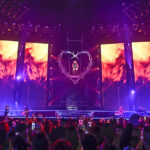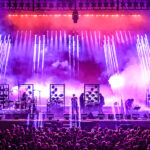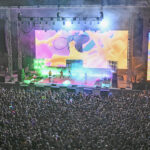
Phil Collins has come out on tour after a self-imposed retirement of several years to wow crowds with his Not Dead Yet tour. Gathering an amazing band, most of whom had played on a previous “Phil” tours, he set out last spring to show the world he still has the vocal chops and the hits to fill arenas full of fans, and to remind them he’s still very much alive.
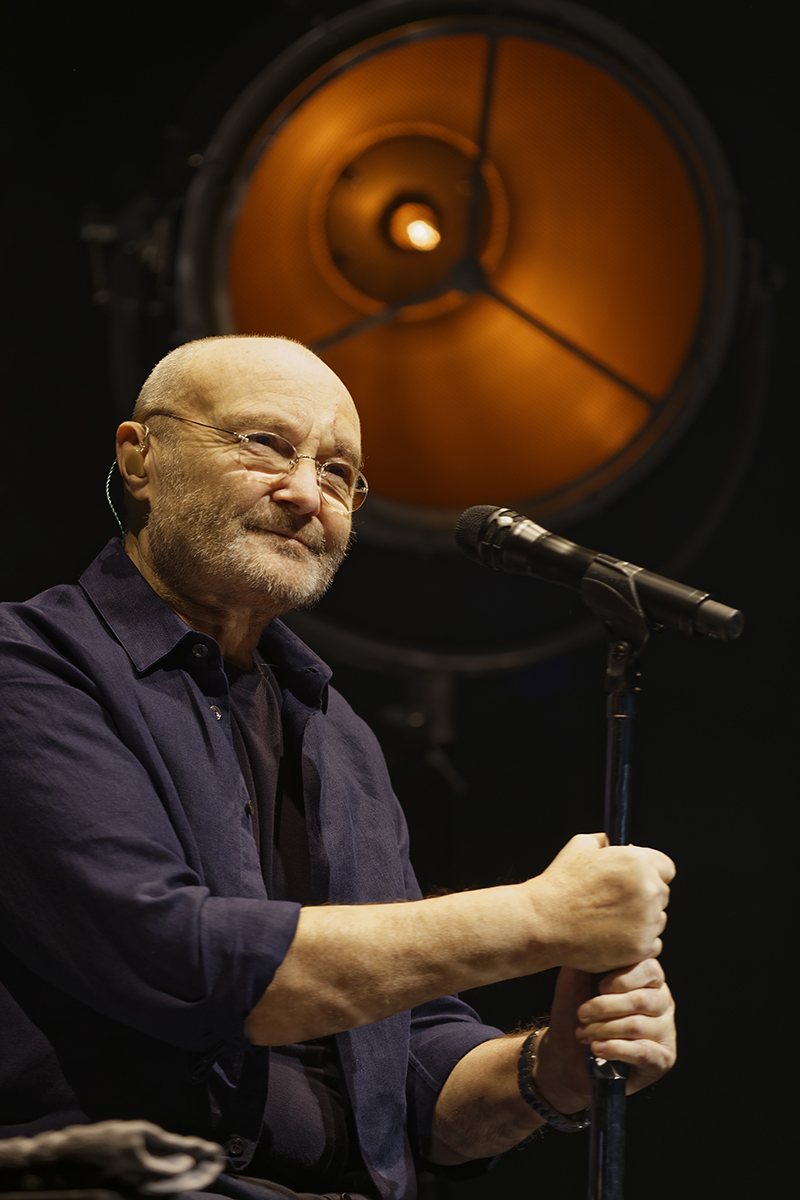
Phil started his career early, joining the band Genesis as the drummer for their second album in 1972. When their original singer left the act in 1976, Collins assumed lead vocal duties and came around the other side of his drum set. He’s never looked back and went off on a solo career while still working with Genesis. He released two albums in 1978, starting off with the acclaimed Face Value. Since then, he’s done plenty of solo worldwide tours, but that streak ended after 1997’s The Trip into the Light tour. Age has become a factor now, as Collins no longer sits behind the drum set; he leaves those duties to his 17-year-old son Nic, who noticeably has his father’s chops. Instead, he takes place in a seat center stage for the show. He appears to be the only one seated in the arena for the two-hour-and-20-minute set.

New to the design team this tour is Roland Greil, a well-respected lighting designer who hails from Germany, or as he prefers to claim, “of Bavarian descent.” Greil has been practicing his craft for many years, but has been kept busy by the Woodroffe Basset Design firm for the last decade. “Everything I’ve done for the last five years has been through this company, and I feel privileged to work with such an outstanding team,” he says. Patrick Woodroffe has looked after Phil Collins as well as Genesis’ production designs for 25 years now. Once again, he was called upon by Phil and his manager Tony Smith to spearhead the production design for this tour.
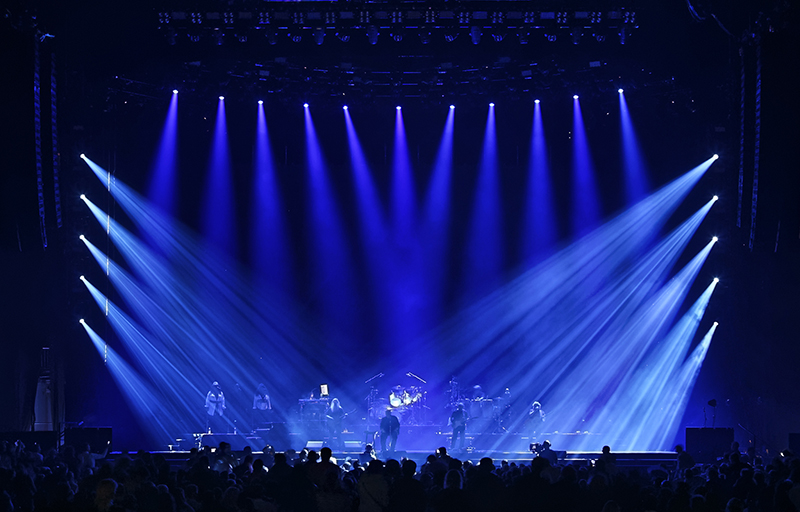
Patrick laid out the guidelines of what he wanted to see and how to approach the lighting. Then he handed the programming and associate lighting design duties off to Greil to come up with tasty looks that seemed to mirror some of the grand looks Genesis was known for. Manager Tony Smith and Genesis were the first band to invest in moving lights, fronting Vari-Lite the startup money, and being the first band to ever use their moving lights. Up until then, moving lights had never been mass produced for a touring rental market.
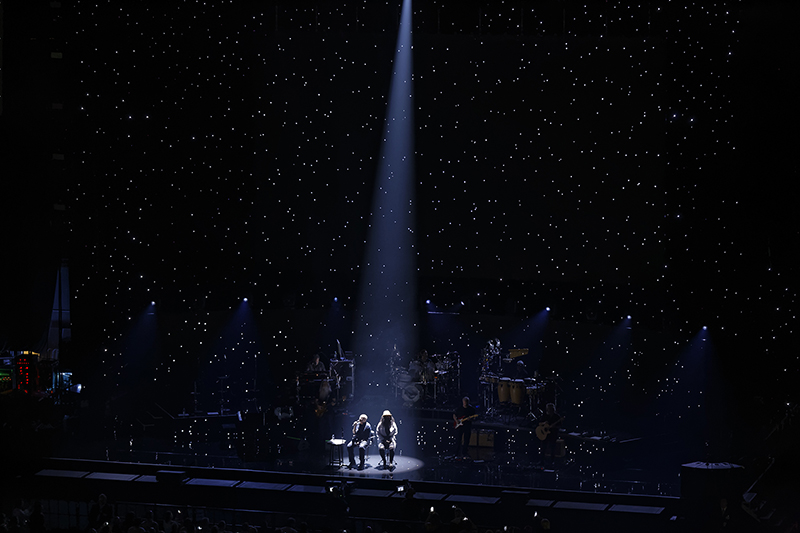
“Patrick left me to put the plot together after he gave me some big ideas,” Greil tells us. “The whole design process was about teamwork, as we were able to tap the resources of set designer Misty Buckley, who may not be a household name in America, but has really come into her own in Europe. She designed a curved one-level tier for the musicians that had the musicians naturally facing towards Phil, downstage center. She gave us the video setup, with the large rear screen for I-Mag, as well as a separate curved video structure that backed the band. Lastly, she lined the riser’s fascia with the same video tiles.”
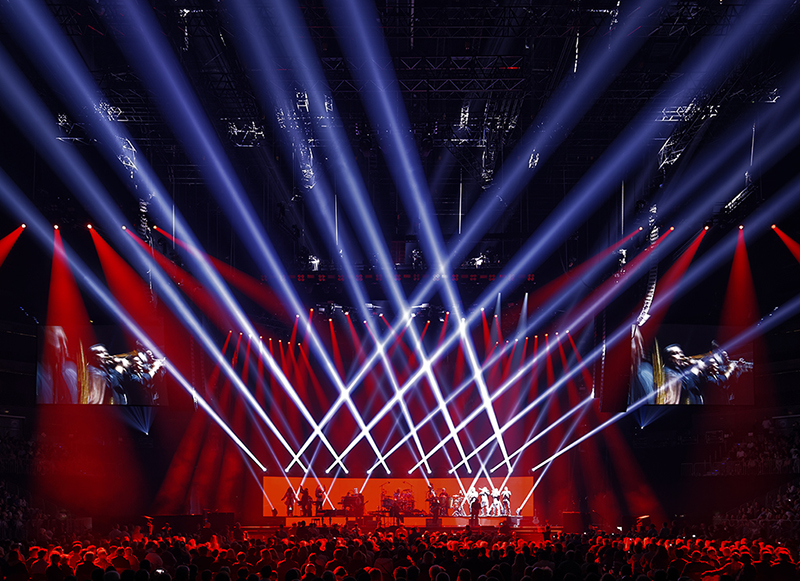
Seated This Time
While those who have seen his show in previous years knew Collins as an active person who roamed the stage, seeing him assuming a center seat for much of the performance makes for a somewhat different scenario. “But at the end of the day it works, because Phil is masterful at stage presence, and the band maintains such a high-energy level.” Greil notes.
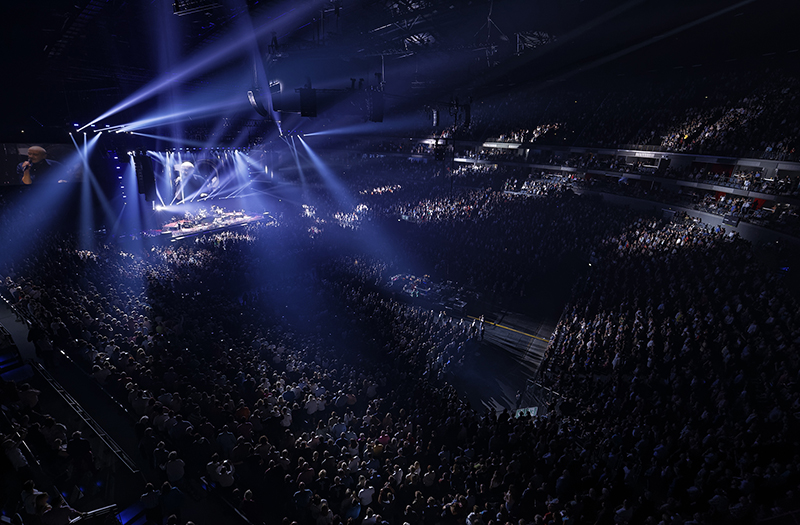
The touring schedule has been quite simple since they first loaded into Neg Earth’s rehearsal facility in London last May to get rehearsals under way. Neg Earth is one of the largest lighting vendors in the world, and someone who longtime tour manager Steve “Pud” Jones and production manager Howard Hopkins stand by. Howard explains why they chose to use the same rig whenever possible. “For as long as I’ve been working with Phil, we have always tried to be one big family out here. Phil likes to see the same familiar faces, and we like to keep everyone busy, but not overworked. None of us is getting any younger. We love Neg Earth. Since we have over a month between legs, it makes it easy for us to slow-boat the lights anywhere we want. We get the same crew and know the gear is already prepped perfectly.”
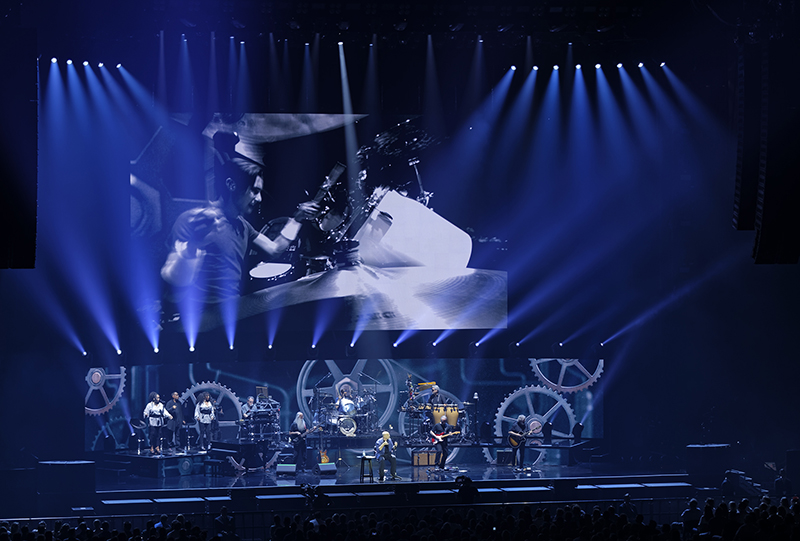
The schedule is leisurely and perfect for many of its players. Roland Greil has been blessed this year. “I’ve been looking after the Rolling Stones and their video on their current tour. They rarely go out for more than a month or two straight, so between the two acts, I’ve been kept busy, yet still find myself able to get some quality time at home with my wife and daughter. We are just completing the last of 15 shows in America before headed home for another break. The first two legs were in Europe, and we followed that with South America. We only carried our floor package down there, as it wasn’t logistically sound to bring the gear there and transport it from country to country and get set up in time for each show.” The tour heads to New Zealand and Australia in January and February 2019.
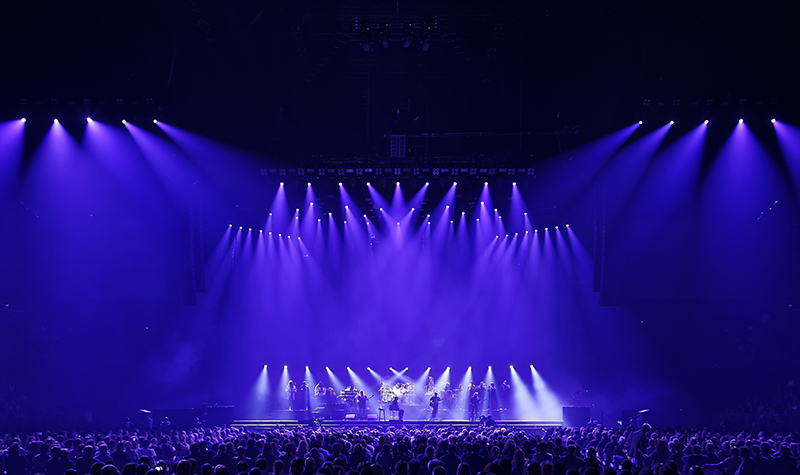
Manager Tony Smith still accompanies his artist on the road. Greil talks about his involvement in the design process. “This man is still very interested in the lighting products and has his own opinions. Sometimes, more than not, he had his own ideas for visuals, and he came around with them. For me, to interact with someone who was part of creating the epic success of moving lights, I was proud and, of course, interested in everything he had to say.”
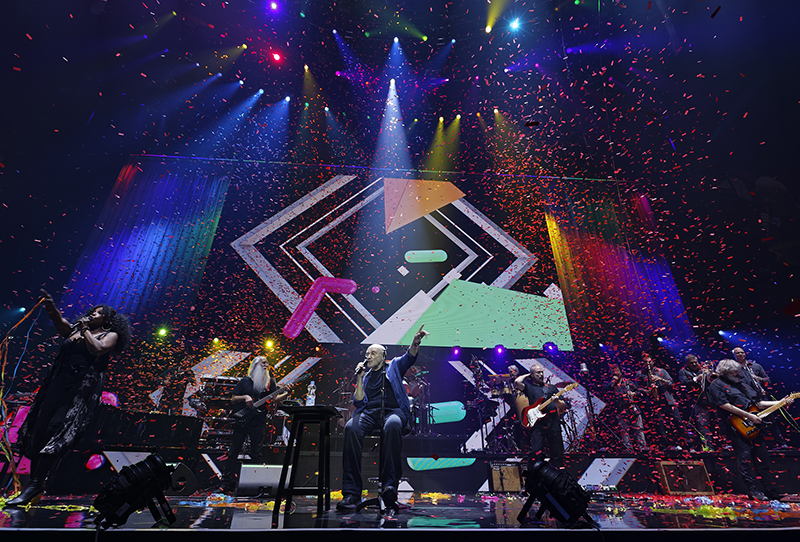
Hard-Edge Fixtures Predominate
Above the stage were three tiered, concentric trusses that alternated Robe BMFL and Claypaky Scenius Unico fixtures. A downstage truss was hung with a similar pattern. Hard-edge moving fixtures predominated, with an ample supply of Solaris Flare fixtures in the rig to bathe the stage and audience in color.
There were two trusses placed upstage left and right that extended off the stage itself. Likewise, there were two “side trusses” that were flown offstage and above the P.A., but facing the crowd. These trusses were all filled with Unico fixtures They were used to shine beautiful fans of identical beams and make the production look much larger than it actually was. These four trusses framed the stage, whether the lights were pointed upwards or through the audience.
Greil expands on fixture choice. “When it came down to fixture choice, Patrick and I agreed that we thought the Claypaky Scenius Unico was a great option for this tour. We came up with a center truss structure over the band that contained Unicos for their beam looks and good optics, especially when patterns were in use. We have been using BMFLs for quite some time, as they make a good choice for use as key lights. We have a lot of band members that cover a bit of stage space, and these cover them perfectly.”
In the upstage corners stood two vertical towers that framed the I-Mag screen, with
BMFLs and Flares in them, giving an extra element to the lighting. The BMFLs are sometimes used as side light cutting through the band and other times as beautiful aerial fans that add more dimension to the stage. For floor lights, Greil went with yet another hard-edged fixture, the Claypaky Mythos.
The lighting took advantage of negative space quite nicely by rarely using all the light fixtures at once. But when necessary, big bold looks were available with everything on at once, which was a pretty big “Wow” factor for the viewer. For most of the show, the stage was lit with monochromatic looks. Of course, up-tempo songs, such as “Sussudio,” warranted the multi-color festive looks.
“Our approach was to keep it simple, not a lot of different fixtures,” Greil says. “The Unicos gave us a strong bold look, a big image using just one type of fixture. The look is similar at times to the big looks of the 80s and 90s — the music and style with which we lit it both fit that era. This allowed us to get away without using any real wash lights and it paid off. The Unicos and Mythos can give us the beam look we need, with the same fixtures. We liked the Mythos because they are smaller, lighter fixtures and integrate nicely in the space allotted on the set.”
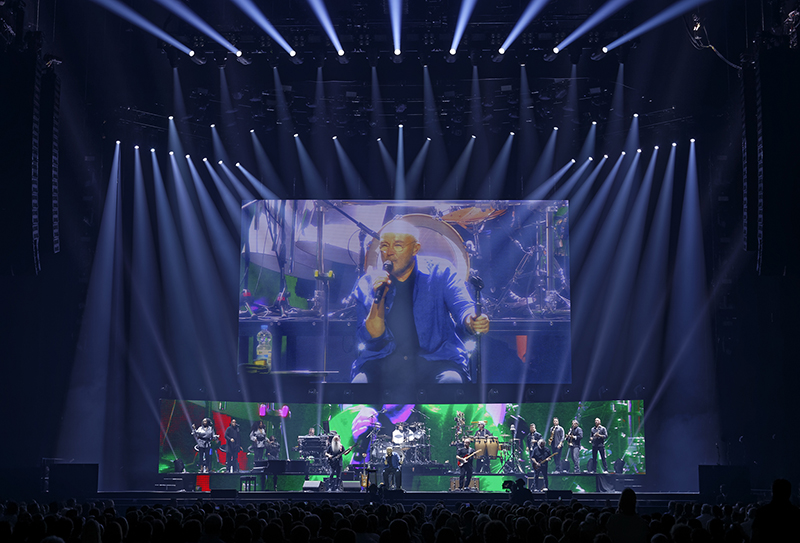
Lighting and Video Control
“The lights and video are all run manually,” adds Greil. “It’s very nice to have a budget where you can split the media and lighting consoles. WBD did this with the Stones last tour and kept with the same pattern here. Cutting the cameras is video director Ruary Macphie, who has been with Phil and Genesis since the 90’s, doing a fabulous job. Behind me at FOH is Joshua Key, who is on a grandMA2 Light. He’s the screens director, deciding what content runs where and when to switch to I-Mag or effects on the camera. With a show that’s run 100 percent manually, it’s much better to have two operators.” The tour utilizes a Catalyst server to play back media.
The show starts with a large white Austrian drape lowered into position. As the crowd walks in, there is a photo montage of Phil through the years projected on the gauze material. Once house lights dim, Phil Collins walks out to center stage, using his cane and all, and settles into the first song while being intimately illuminated by a couple of Robe Patt 2013 vintage looking fixtures on rolling stands. A couple of stubby par 64 fixtures illuminate him from the floor at times, creating a theatrical look on the artist. Greil expands on this. “The gauze is thick enough to act as a projection screen, but sheer enough that we can shadow the band, silhouetted from behind on it. On the start of the second song we lift the drape to reveal the band standing on their curved riser.
“We do still like to keep a few old theatrical lighting tricks in hand,” Greil adds. “For one song, we make use of an old fashioned star cloth as Bridgette Bryant, one of our background vocalists, comes downstage to join Phil for an intimate duet.” At the end of the show, the Austrian lowers back in, signaling the end of the evening.
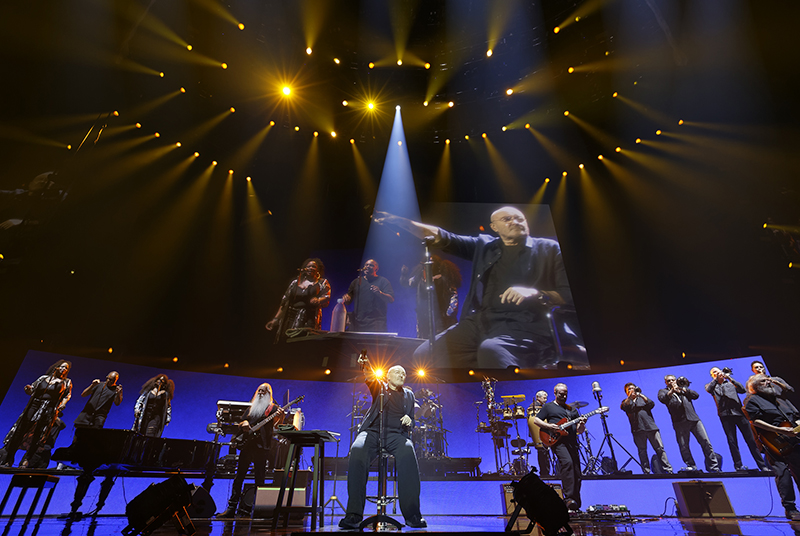
The Followspot Setup
The director is utilizing four FOH spots out front as well as a single Robe BMFL
RoboSpot fixture upstage center for backdrops. The spots are most of the times on Phil, and for a few times, used for solos on stage. Greil expands on this logic. “In Europe, we carry two 4K Robert Juliat Lancelot followspots. They are really good and reliable spots, and because house spots in Europe tend to be worthless, they are a necessity. In America, we can always find four FOH spots we can use, but of course they are subject to different intensity levels and color temperatures due to the age of the bulbs. Sometimes one or two may fail, and it’s imperative that we have enough firepower to properly light the artist at all times, because as you can see, there are a lot of bright lights used on stage.
“This tour has been another successful collaboration with Dave Ridgway and Neg Earth, as they have provided a flawless and great lighting system for the show,” Greil says. “On the road, I have been blessed once again to have some of the greatest crew an LD could imagine with me. A crew headed by my long term partner in crime Luke YC Radin, made my life easy once again.”
As for the artist, Greil says, “We couldn’t work with a better guy. He has his own opinions he may bring up, but they are good points and he is a very down to earth, laid back, polite man. I’ll tell you, the older artists appreciate all the work we put into making productions like this great, something we don’t see with a lot of the younger artists these days. We appreciate that this artist is well aware of what we do.”
Phil Collins Not Dead Yet Tour
Crew
Manager: Tony Smith
Lighting and Production Design: Patrick Woodroffe
Associate Lighting Designer: Roland Greil
Set Designer: Misty Buckley
Video Content: Sam Pattinson & Lizzie Pocock/Treatment Studios
Lighting Programmer/Lighting Director: Roland Greil
Lighting Director: Roland Greil
Media Server Programmer and Operator: Joshua Key
Video Director: Ruary Macphie
Lighting Crew Chief: Luke Radin
Dimmer Tech: Matt Flood
Lighting Crew: Barry Banford, Andy HED Thompson, Jake Wittingham, Neil Johnson
Production Manager: Howard Hopkins
Tour Manager: Steve Pud Jones
Production Assistant: Michelle Pekrol
Carpenters: Nigel Dobson, Richie Baron
Video Crew: Ray Gwilliams, Freddy Debaillie, Michael Cordier, Anthony Barratt, Thomas Kozmiuk,
Head Rigger: Steve Armstrong
Rigger: Mike Fowler, Tom Armstrong
Lighting Vendor: Neg Earth
Video Vendor: Matrix Touring
Staging: Brilliant Stages
Gear
2 grandMA2 full sized consoles
1 grandMA2 Lite
47 Robe BMFL Spots
58 Claypaky Scenius Unicos
35 Claypaky Mythos
2 Robe PATT 2013
46 GLP X4 Bar 20’s
45 Solaris Flares
25 Four-Lite Moles
2 Stubby Par 64’s
1 2k Fresnel
2 Robert Juliat 4K Lancelot followspots
1 Robe RoboSpot system
3 MDG The One smoke machines
3 Martin AF2 fans
